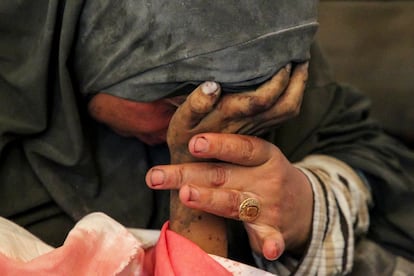Gaza’s fuel war deepens with Israeli blockade of Rafah border crossing
The UN estimates that the Strip has only enough fuel left to last one to three days, putting at risk the delivery of humanitarian aid and the operation of hospital equipment and water pumps

Fuel is a fundamental pillar upon which rests the survival of hundreds of thousands of Gaza inhabitants. Just a thousand of the slightly more than 25,000 trucks that have managed to reach the Strip during the war have carried this essential item on board, according to United Nations statistics. This constitutes less than 4% of total vehicles. Every single one accessed Palestine through the Rafah border crossing, which separates the territories from Egypt and which, on Tuesday, was taken by Israeli occupying forces.
Since then, the border crossing has remained closed and no humanitarian aid has been allowed to enter, warn the UN and other organizations. That includes fuel, without which it will be impossible for vehicles carrying aid to circulate, and for generators and equipment, with which an already damaged Gazan healthcare system is trying to function. “Supplies of food and fuel in Gaza will only last 1-3 days. Without them, our operations will go into standstill,” says the UN World Food Programme (WFP)’s top official for Palestine, Matthew Hollingworth. He paints a bleak picture. The agency’s main warehouse is “inaccessible,” Hollingworth says, adding that no aid has been able to arrive for two days via the crossings at Rafah and Kerem Shalom, which Israel also controls.
In addition, thousands of people are fleeing after Israel threatened to carry out a large-scale invasion in the area, where only one bakery has been left open, Hollingworth said on the social media platform X (formerly Twitter). The commissioner general of the UN Relief and Works Agency for Palestine Refugees (UNRWA), Philippe Lazzarini, and the director general of the World Health Organization (WHO), Tedros Adhanom Ghebreyesus, have expressed similar concerns. The latter had already announced on Tuesday that Rafah’s Al Najjar hospital was no longer functioning, and that other hospitals in southern Gaza had only enough fuel to last for three more days.
Warnings of the serious problems being caused by the shortage of diesel fuel, gasoline and gas are growing, and have been echoed by the non-profit Refugees International. “If fuel is cut, aid operations collapse and collapse fast. That means that you can’t pump water, keep the lights on in hospitals and that vehicles cannot distribute aid,” says Jeremy Konynkyk, the organization’s president, in an online appearance on Wednesday alongside the heads of other organizations that are deployed in Gaza.
The shortage also directly affects the street price of fuel, which, like food, has undergone hyperinflation. A liter currently costs $40, says Helena Ranchal, head of Doctors of the World, who is currently in Nablus, in the West Bank. And the longer trucks are banned from entering, the higher prices will rise. “We’re not just talking about the mobility of people, of equipment. We need the electrical system in hospitals to work in order to be able to make blood transfusions and carry out surgeries,” she says, emphasizing: “Healthcare workers can’t go on like this much longer.”
On top of this is the fact that fuel is necessary for the various needs of individuals, businesses and humanitarian organizations, from vehicles to feeding generators that complement the solar panels of offices and companies and for charging electronic devices.
Some of the families who have had to escape Israeli attacks in Rafah are moving for the ninth time since the war began last October, says Hollingworth. 80,000 people have fled Rafah as of Thursday, according to figures from the UNRWA. They’re leaving behind a place that not only continues to be partly (on its eastern side) occupied by the Israeli military, but is being bombed by air and attacked with artillery, leaving dozens of civilians dead every day.
“Around 70% of the 2.3 million residents of Gaza live in a constant cycle of displacement and flight,” says Ghada Alhaddad of Oxfam, who is currently in Deir al Balah, in the central part of the Strip. This is due to “illegal forced displacement,” says Ranchal. “It’s a lie, there is no safe zone in Gaza,” she in response to an announcement made by Israeli authorities to the citizenry for them move to the camp in Al Mawasi, northeast of Rafah. Both women participated in the virtual panel with Konynkyk.
Hollingworth thinks it would be “catastrophic” for troops to invade southern Gaza, which is currently home to some 1.5 million people. The limited progress that had recently been made in helping residents would be lost, and with the current blockade of border crossings, “the operations that are being carried out by agencies like PMA would have to halt,” he warns. He calls on authorities, in the lack of a ceasefire agreement, to at least permit humanitarian activity.
“Today we realized that, due to the lack of fuel, transportation is extremely expensive. It’s madness what it costs for our trucks to move our goods from one place to another. The price they’re asking is triple what it is on normal days,” says Rafeek Elmadhoun of Rebuilding Alliance. The organization is trying to relocate its kitchen to areas receiving people who are fleeing Rafah. To this rising price of fuel is added the problem of “lack of fresh foods like vegetables, because prices have shot up due to the impact [of the war] on the agricultural season. The price of tomatoes and potatoes will drive you crazy,” he adds.
On the Israeli side, things are not looking promising. On Thursday, some 150 people prevented a humanitarian aid truck convoy coming from Jordan from advancing towards Gaza. A group of protesters, among them family members of the October 7 Hamas attack, blocked the convoy and threatened its drivers, according to images that have been published by several media sources. On that day, hundreds of Hamas militants attacked the wall that separates the Strip from Israel, killing 1,200 people and taking hostage 250 more, according to official figures. Israel’s military response has thus far claimed 35,000 lives on Palestinian land.
Sign up for our weekly newsletter to get more English-language news coverage from EL PAÍS USA Edition
Tu suscripción se está usando en otro dispositivo
¿Quieres añadir otro usuario a tu suscripción?
Si continúas leyendo en este dispositivo, no se podrá leer en el otro.
FlechaTu suscripción se está usando en otro dispositivo y solo puedes acceder a EL PAÍS desde un dispositivo a la vez.
Si quieres compartir tu cuenta, cambia tu suscripción a la modalidad Premium, así podrás añadir otro usuario. Cada uno accederá con su propia cuenta de email, lo que os permitirá personalizar vuestra experiencia en EL PAÍS.
¿Tienes una suscripción de empresa? Accede aquí para contratar más cuentas.
En el caso de no saber quién está usando tu cuenta, te recomendamos cambiar tu contraseña aquí.
Si decides continuar compartiendo tu cuenta, este mensaje se mostrará en tu dispositivo y en el de la otra persona que está usando tu cuenta de forma indefinida, afectando a tu experiencia de lectura. Puedes consultar aquí los términos y condiciones de la suscripción digital.
More information
Archived In
Últimas noticias
Most viewed
- Alain Aspect, Nobel laureate in physics: ‘Einstein was so smart that he would have had to recognize quantum entanglement’
- David King, chemist: ‘There are scientists studying how to cool the planet; nobody should stop these experiments from happening’
- Mexico completes its trade shift with the entry into force of tariffs on China and countries without trade agreements
- Reinhard Genzel, Nobel laureate in physics: ‘One-minute videos will never give you the truth’
- Oona Chaplin: ‘I told James Cameron that I was living in a treehouse and starting a permaculture project with a friend’











































